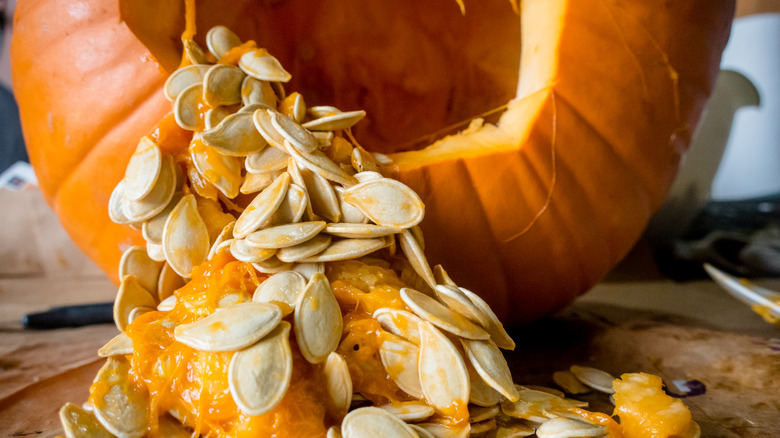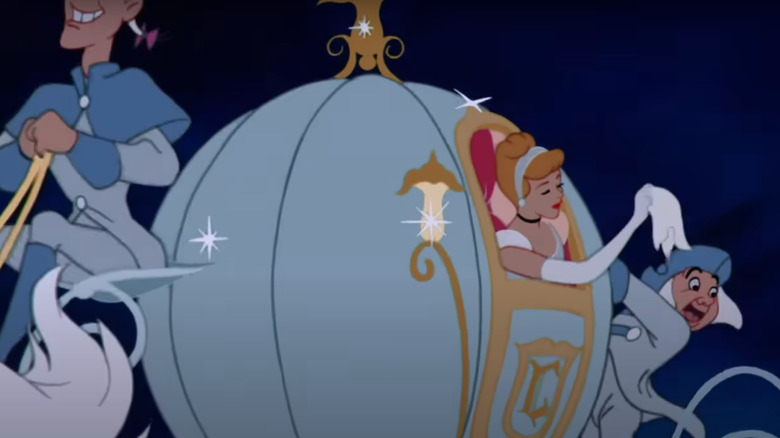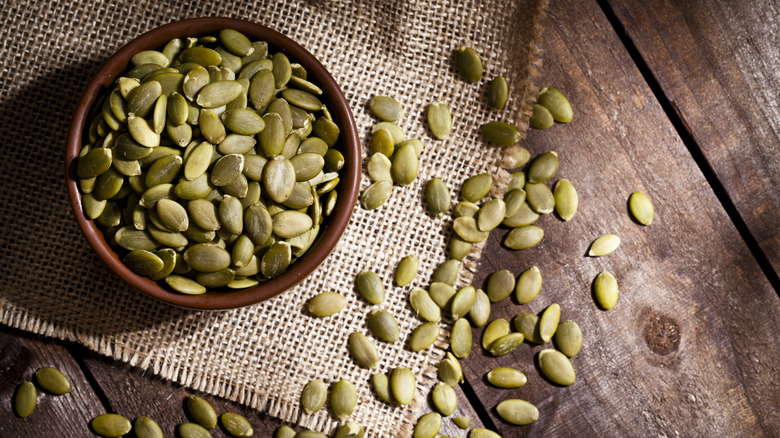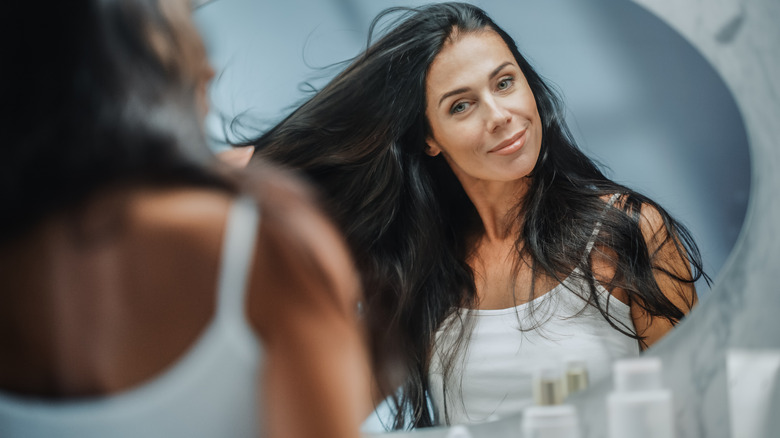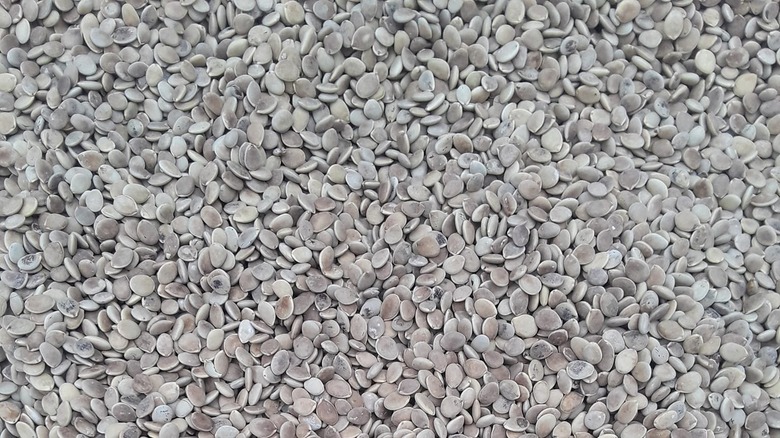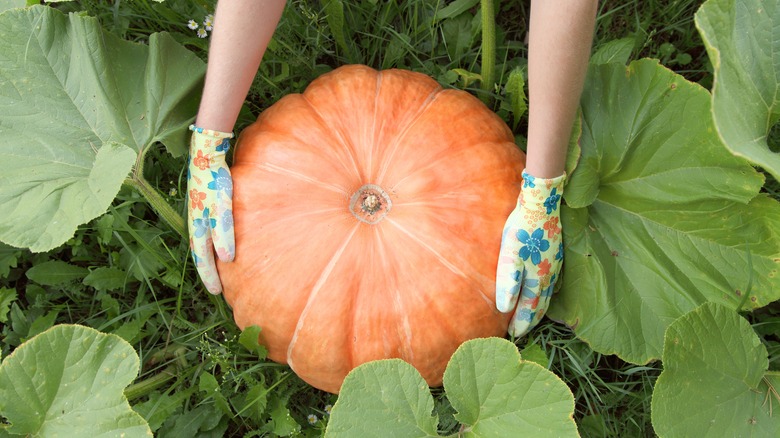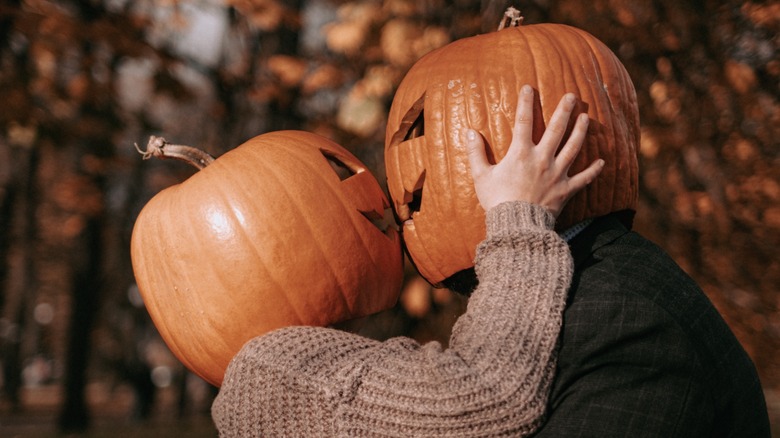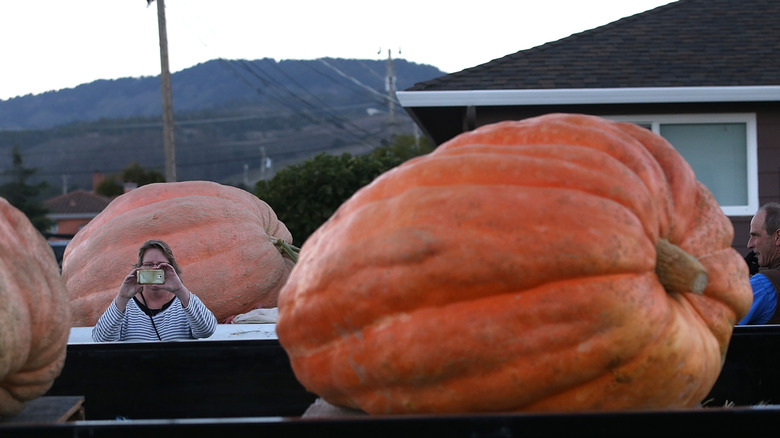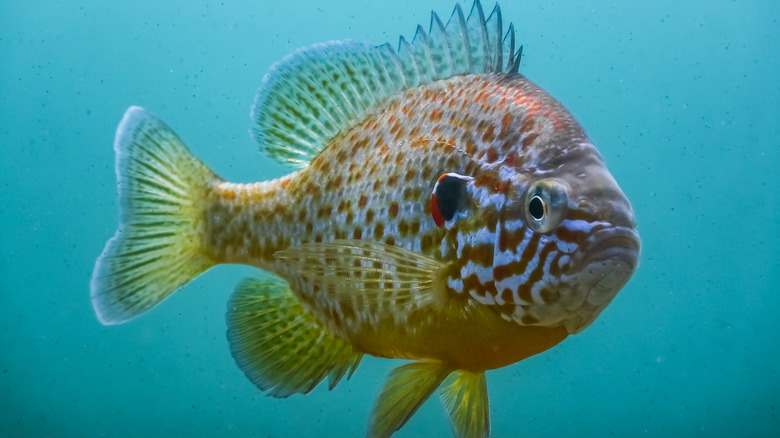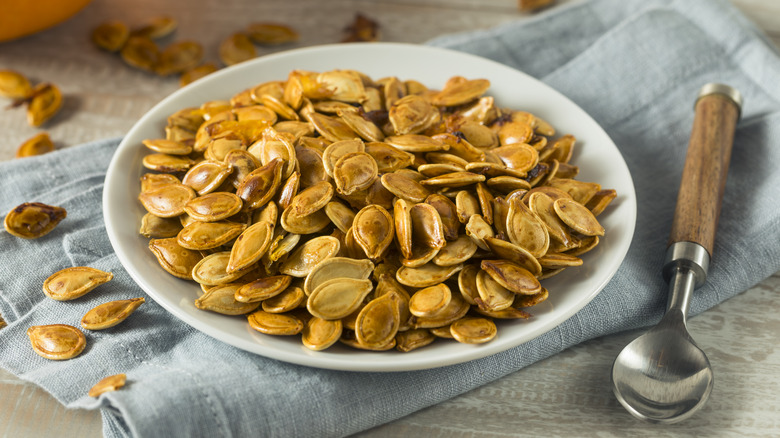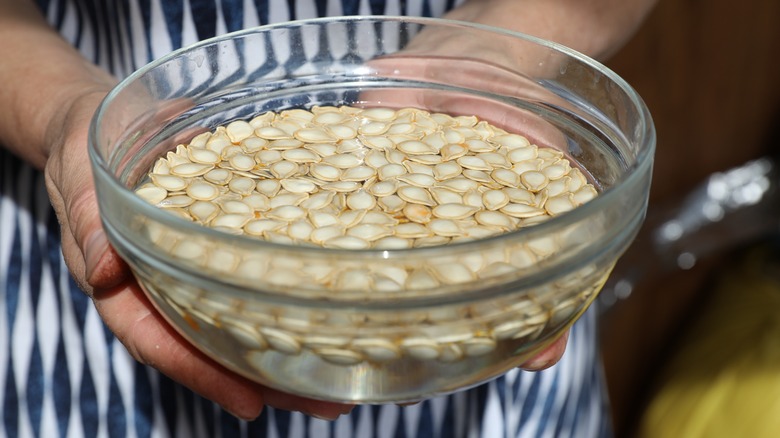Everything You Want To Know About Pumpkin Seeds
Some of us see a regular pumpkin. Some see an orange gourd. But the rest of us see a glorious vehicle for hundreds and hundreds of perfectly crunchy, sweet or spicy about-to-be roasted pumpkin seeds. That is, after we get rid of all those stringy pumpkin guts. Eesh!
Can we also just admit how much we love to bust out ridiculous food trivia at just the right moment? (Preferably when everyone else's mouths are chock-full of pepitas, so they can't correct our internet facts.) This spooky season, we're throwing the curtains wide open on literally everything you could ever want to know about the number one Halloween snack. (Other than Reese's Peanut Butter Cups, duh.)
What the heck do pumpkins have to do with Cinderella? How are woolly mammoths even involved? Hold your horses, "Fifty Shades of Grey," is this even suitable for work? Sorry, did you think you're in for another one of those lame lists about pumpkin seeds? Pssh! We wouldn't disrespect pepitas like that. Secure your Melon Locos! These are the craziest deets on our favorite part of the pumpkin!
What's Cinderella got to do with it?
We often fantasize about the origins of food culture, but from a comfortable distance into the future. Like, who was the first person to discover that you could eat an egg. Who tried it? Were they like, "Hmm. Wonder if these are good?" Did they just bite into a raw egg and realize maybe we should cook it? What about a banana? Who was like, "No, no, no, guys, this one we eat the inside seed part, not the outside like we're doing for apples. Is anyone writing this down? Do we have a language yet?" Whichever way the real history shakes out, someone had to be the first. And when it came to the term "pumpkin," the first to ever speak this word was, in fact, Cinderella. Well, kind of.
If you're picturing the chubby mice with the little hats in the 1950s Disney version, the first iteration of our friend Cindy came about way earlier than that. The most popular Cinderella story existed back in 1697: "Cendrillon, ou la petite pantoufle de verre," by French author Charles Perrault. In it, the fairy godmother asks Cinderella to go fetch a "pompon" (French for pumpkin) from the garden. Once the story was adapted for an American movie-going audience, the stroke of midnight meant that Cinderella's glamorous carriage would be turning back into a "pumpkin."
With the Greek first calling this strange big melon a "peopon," and the French and English adapting it to "pompon" and "pumpion," Americans were like, okay, enough of this, it's a "pumpkin," let's move on with our lives.
Snack time, but make it 7000 B.C.
Back in 7000 B.C., those of us living in North America kicked back on a Saturday afternoon with a big ol' plate of barbecue bison skewers, rabbit bites, and an ice cold — eh, room temp — cup of fermented grapes. Of course, we also needed some shells to spit while we watched the place where our TV would go in 8,000-ish years. (Basically like one of those really long pharmaceutical commercials.) Luckily, pumpkin seeds existed back then too.
A North American discovery, the first known pumpkin seeds hit the big time in Mexico where indigenous people capitalized on the life-giving guts of this versatile squash. These delicious "pepitas" were part of an agricultural system that had beans, pumpkins, and corn on lock. Bonus, you could eat an entire pumpkin top to bottom (well, maybe not the stem). It was a killer food to have on hand back when there were, like, pet woolly mammoths. (Ugh, please let there have been pet woolly mammoths.)
Next time you're snacking on roasted pumpkin seeds, snuggled up with your own woolly mammoth (Fluffy, we hope that's you lurking around the snacks), chillin' on the sofa with the TV on, take a moment to think of the breadth of geological eras that had to occur just so you could be sitting there mindlessly eating and scrolling on your phone. A modern marvel.
Put some hair on ya chest (and head)
Notice a little thinning in that once thick and luxurious mane? Get your pepitas on, papi (y mami)! Pumpkin seeds act as a delicious alternative to, say, non-edible Rogaine, helping to slap those hair follicles back into tip top shape.
The oil in these babies is known to block DHT, a hormone that can get a little overactive around the hairline in adults, creating hair loss. Whether it's applied as a topical treatment, or incorporated into your diet as crunchy seeds or a liquid concentrate, pumpkin seed oil throws down against too much DHT by sending in key nutrients to create a healthy, flourishing scalp. Check you out, with your hair all blowing in the breeze.
As for how many pumpkin seeds you will need to eat in order to possibly attain this particular 40 percent surge in hair growth, it's about 400 milligrams of pumpkin seed oil, daily, for roughly six months. That equals around 1.5 tablespoons of pumpkin seeds — without their shells — every day. Beautiful hair never tasted so good.
The no-name melon loco seed
Let's get loco. There exists an extremely rare pumpkin seed in the United States that never even got a name (Cinderella, you dropped the ball on this one) because it came from a squash that exactly zero people agreed to eat. Except, surprise, this seed is delicious. Flash forward to now, and it's a cherished treat for those who know and love them.
They're called "acualaistas" and they're packed inside the apodanthera undulata, or Melon Loco. It's a rough and tumble, stinky, bad-tasting pumpkin that grows in the southwestern U.S., as well as Mexico. And it got its nickname because anyone that ate it was clearly crazy. Except, looking back, maybe they were geniuses who skipped the putrid pulp and then had the delicious seeds all to themselves.
Acualaistas are hard to find, unless you stop by certain towns in Mexico. But even then, they're not exactly popular. Maybe it's because they involve an enormous process to harvest, including an alkaline soak, what amounts to a spiritual cleansing of the ghost of the squash flavor, a sun-drying, and finally a roasting. All for a tiny seed that's the size of your pinky nail. But if you see them? Snap them up. It's worth living a little on the wild side for a taste of these things.
Stay regular
Please never Google what happens when you eat too many pumpkin seeds. Because we already did that and can never un-know this information. According to a few brave souls who have gone before us, they did what should never be attempted on the human body. Not to get too graphic, but days-long constipation, followed by explosive number 2 — made entirely of pumpkin seed hulls — was, indeed, a main feature.
For the record, if you're asking the American Heart Association, it's good to limit your seeds to a 1/4 cup per day, max. Even if they're roasted and candied in cinnamon and brown sugar. Yes, even then, friends. You don't want to become a cautionary tale on a forgotten subreddit.
Eating a sensible amount of pumpkin seeds on the daily can even do the opposite of the aforementioned terror; and that's keep you regular. These little guys are loaded with fiber. And you can eat them with, or without, the shell. Just a single ounce of shelled seeds serves up 1.7 grams of fiber. That'll fill you up and keep things flowing, any day of the week.
Halloween in June
Now that we've all fully-embraced the homesteading trend of the past several years, what the heck do we do with our gardens in the fall? Well, collect our pumpkin harvest, of course! But if you want to DIY your own pumpkin seeds, you're gonna need to plant ahead for that perfectly ripe autumn squash.
Wanna creep it real with a masterpiece jack-o-lantern displayed next to your roasted pumpkin seeds? Typically, pumpkins take anywhere from 85 to 125 days to grow. So to have a mature squash for spooky season, you'll need to plant that sucker in June. Yes, that's four months before you ever start thinking of sweater weather, Uggs, and pumpkin-spiced anything. Hello patience! We believe in you.
Once you pencil this in on the calendar, you can relax knowing that a ripe pumpkin can continue living its best life for up to five months off the vine, as long as you don't carve into it. To get the most bang for your buck, choose a variety like Kakai or Styrian "seed pumpkins," that are bred to produce seeds that have no shell. Roast, toast, and done!
Let's get physical
You know how in the movies when things are getting hot and heavy, how people always bust out a bag of pepitas and feed them to each other? Oh, nobody does that? Well turn down the lights, and turn up the slow jazz, because just like oysters, chocolate, and strawberries, pumpkin seeds are a total aphrodisiac. Bow-chica-wow-wow.
Roasted pumpkin seeds may have an, ahem, uplifting impact on the symptoms of erectile dysfunction. They might also boost fertility, and sperm production, and they benefit prostate health in general.
But the satisfaction extends to the ladies, too. That zinc in the seeds that gets your heart beating faster and faster? That's one trace mineral that gets everybody's engine revving. If you really want to turn up the heat, ditch the fuzzy handcuffs and the edible ... whatever that is you have in your Amazon cart. And grab a bag of pumpkin seeds to really have some fun under the covers.
Big pumpkins, big money $eeds
Welcome to Big Pumpkin, kids. Where world record-holding squash demands jaw-dropping prices for a single chance at that gourdgeous lineage. Want in? You better be rolling in the lettuce, baby! (We're doing a garden metaphor — just go with it.)
2022's winning 2,560-pound pumpkin — the reigning champ for biggest-ever pumpkin grown outdoors, as well as hugest pumpkin in all of North America — also grew some big ol' seeds. And you can buy just one of those seeds for a cool $299. Of course, it will also probably be triple the size of your average pumpkin seed.
But that's pennies compared to the most expensive pumpkin seed ever sold. A $2,000 seed was purchased during the 2015 World Pumpkin Commonwealth Conference (totally imagining everyone flew there on brooms) by a British seed company, Thompson & Morgan. They were aiming to break the scale for the biggest pumpkin ever grown. While they managed to grow a truly gigantic pumpkin at 1,500 pounds, their own craziest record remains the eye-popping price of that seed.
A little fishy
Pumpkin seeds aren't just from pumpkins anymore. They're also swimming around in fresh water ponds. Meet the Pumpkinseed fish. And if you think it looks like one of those sunfish you used to catch when you went fishing as a kid, that's because it is! They also go by the nicknames pond perch and punkies. Cutest fish name award, right here.
While they may have gotten their name from being shaped like 4-inch-long pumpkin seeds, they sure don't have the same coloring. Pumpkinseed fish feature neon blue and green scales that contrast their darker-hued, orange and brown bellies. They like to hang out near the shore, in calm vegetation, making them easy to snag on the line.
Just like roasted pumpkin seeds, these fish are mighty tasty if you like a light, slightly sweet flavor. You can roast them whole (just like the seeds), or just observe them in their natural habitat. And then invite them over to your camp for s'mores later. (See ya later, Pumpy! We're calling him Pumpy now.)
To your health!
We are so down for a go-to snack that's healthy without tasting like it. And pumpkin seeds definitely rise to the challenge. We might even call them a superfood if it weren't for the fact that they're much more budget-friendly and accessible than the goji berry/Blue Majik spirulina crowd. No offense.
So what's inside these glorious little seeds? Let's dig in. They're packing a bunch of magnesium, which lowers stress, and tryptophan which helps with managing depression, as well as getting better sleep. A serving of antioxidants fights free-radicals, and micronutrients like iron and copper keep you energized throughout the day.
They're also loaded with omega-3 fats. Those are the healthy kind that are good for your heart. And the cucurbitacin (pronunciation = you're on your own people) complex found in pumpkin seeds can even encourage your body to flush out parasites. Despite all the good parts, eating too many pumpkin seeds cancels out the health benefits and adds the risk of weight gain, bloating, and general digestive unhappiness. Consider yourself warned.
Soak 'em and roast 'em
You might know your favorite roasted pumpkin seed recipe like the back of your hand. But what if we told you they're a lot easier on the ol' tum tums if you do just one simple, extra step. (Okay, sadly, it's not covering them in chocolate and Butterfinger crumbles. Let's just get that out of the way.)
The method involves soaking the seeds before you roast them. After scraping off all the orange gutty stuff from your seeds, let them chill overnight in a bowl of room temperature water, sprinkled with 1 tablespoon of salt. Your newly tenderized seeds will then need to be patted dry, and roasted about 10 minutes longer than the already-dry variety. You can do the same thing even faster by boiling the seeds in salted water for 10 minutes, instead of soaking them overnight.
But if you really want your roasted pumpkin seeds to go down smooth, add a little whiskey. And then say "drunken pumpkin seeds" five times really fast. Boozy seed recipes incorporate things like smoky bacon drippings, raw pumpkin seeds, brown sugar, and your favorite whiskey, simmered until it's sticky and candy-like. Let the seeds cool on a baking sheet, and before you know it, you'll have all the adult-aged trick-or-treaters in the neighborhood waiting by your front door.

